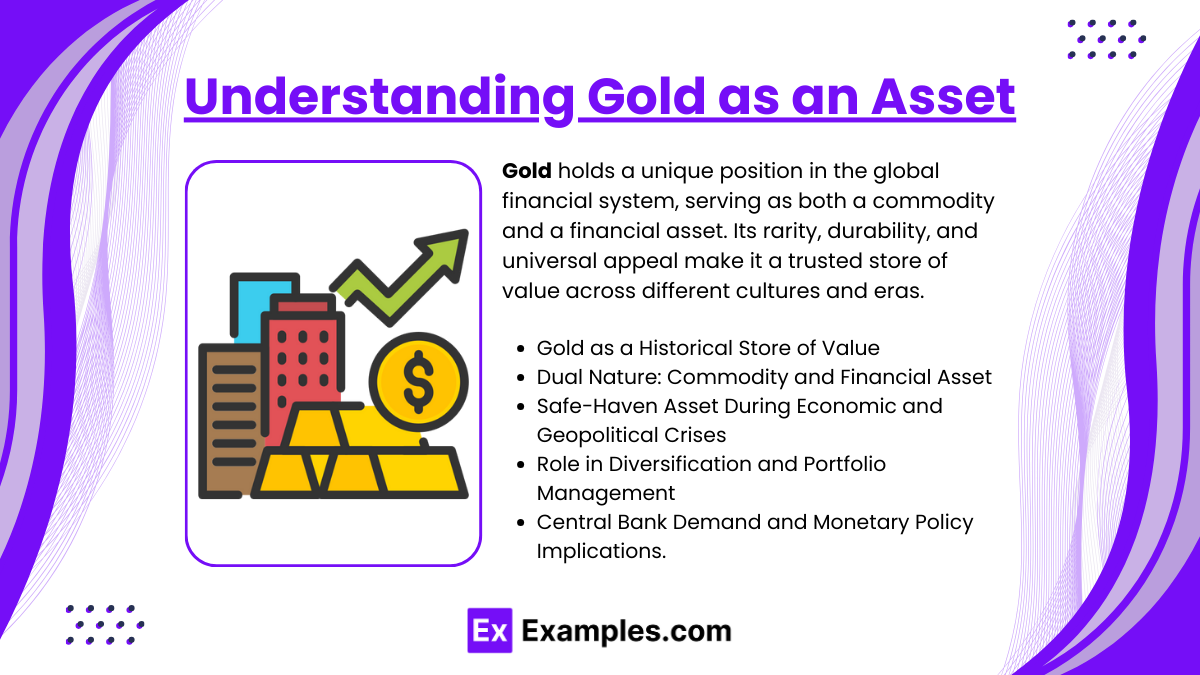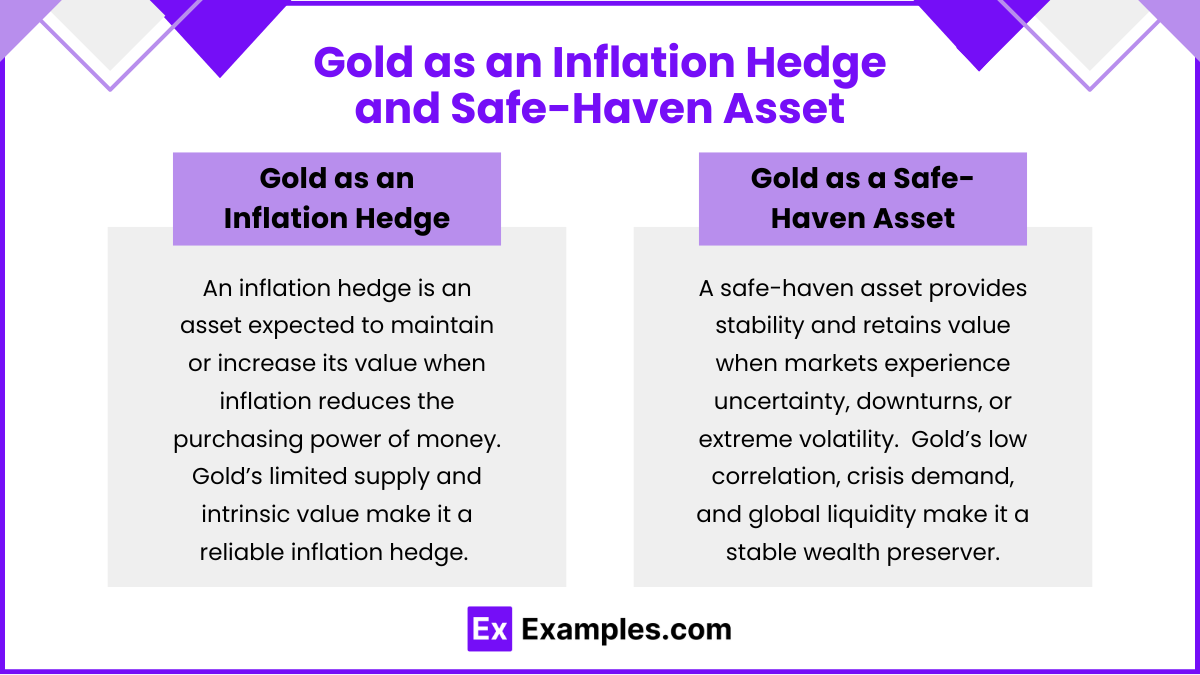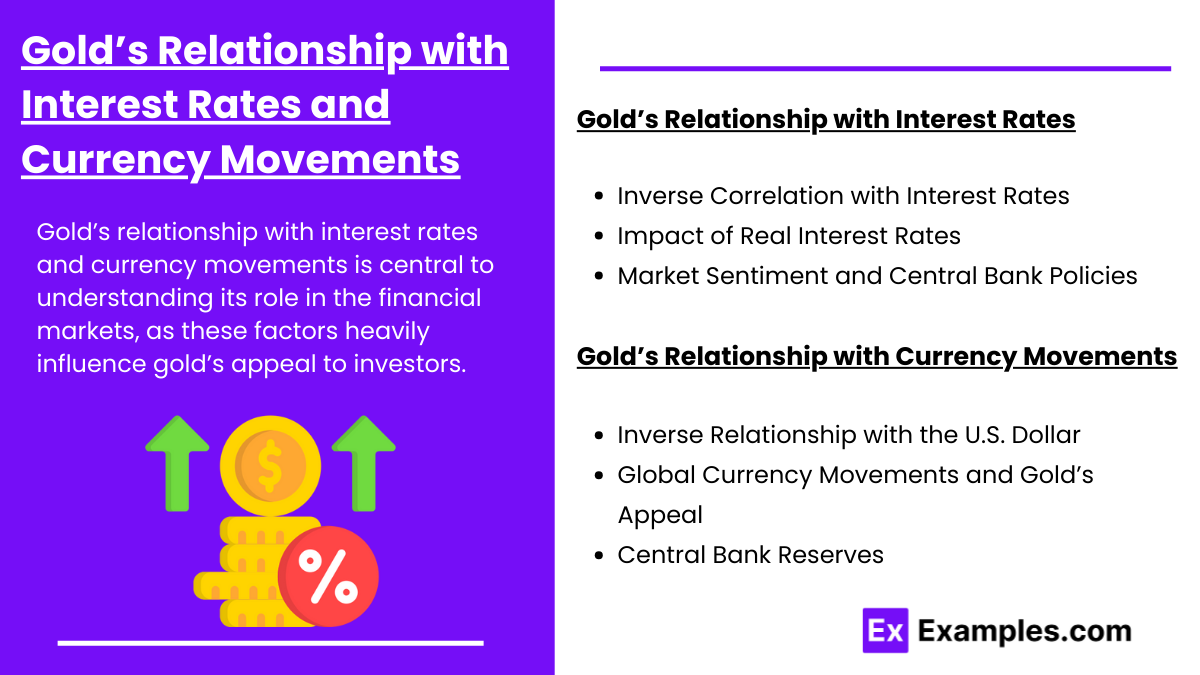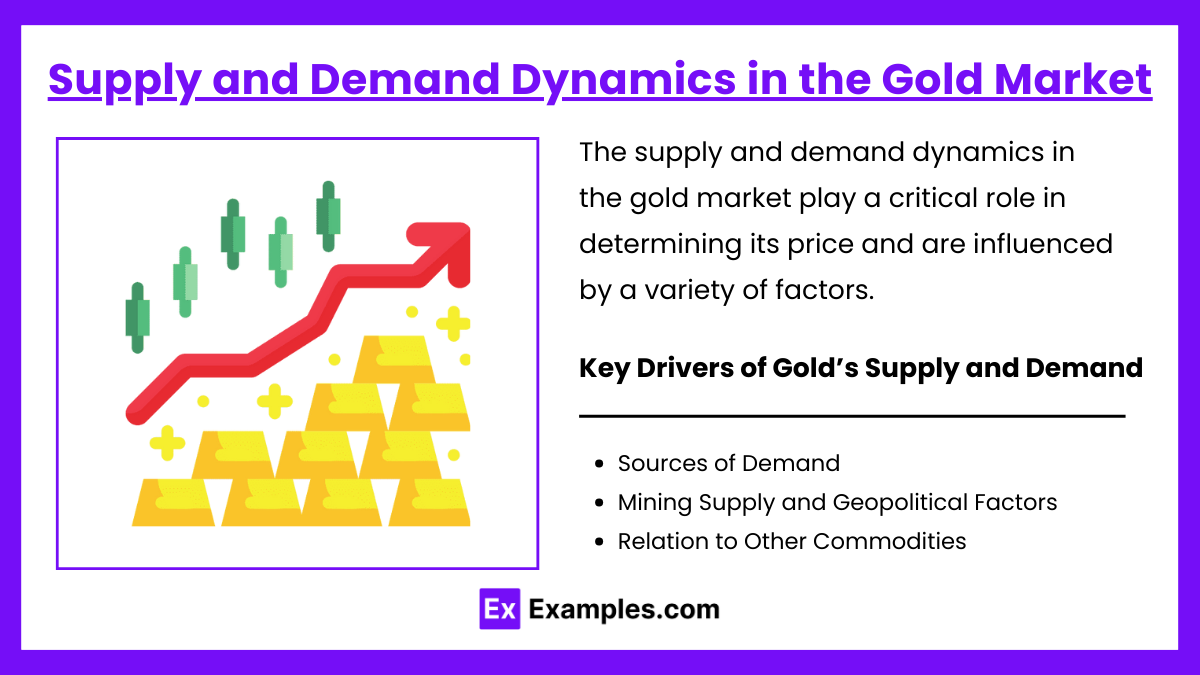Gold holds a distinctive position in financial markets, acting as both a commodity and a safe-haven asset, especially during economic uncertainty. Known for its inverse relationship with the U.S. dollar and equities, gold often rises in value when traditional markets face downturns, providing stability and diversification in investment portfolios. Its role as an inflation hedge and currency protector makes it appealing to investors worldwide. Understanding gold’s market dynamics and technical patterns is essential for leveraging its potential in portfolio management and risk assessment.
Learning Objectives
In studying “Section II: Asset Relationships: Gold” for the CMT Exam, you should learn to understand gold’s role as a unique asset class and its correlations with other markets. Analyze gold’s behavior as an inflation hedge and safe-haven asset, especially during economic uncertainty. Evaluate the relationships between gold and interest rates, stock markets, and currency values, particularly its inverse relationship with the U.S. dollar and equity markets. Additionally, explore how technical analysis tools—such as trendlines, moving averages, and volume indicators—aid in interpreting gold price movements, and apply your understanding to assess gold’s potential impact on portfolio diversification and risk management strategies.
Understanding Gold as an Asset

Gold holds a unique position in the global financial system, serving as both a commodity and a financial asset. Unlike other commodities used mainly for industrial or commercial purposes, gold is valued for its intrinsic qualities and historical role as a form of currency. Its rarity, durability, and universal appeal make it a trusted store of value across different cultures and eras.
- Gold as a Historical Store of Value:
- For thousands of years, gold has been perceived as a reliable store of wealth. Ancient civilizations, such as the Egyptians, Greeks, and Romans, valued gold for its scarcity, beauty, and malleability, using it for currency, jewelry, and religious artifacts. This historical legacy has influenced modern investors, who still view gold as a secure asset during uncertain times.
- During periods of hyperinflation or extreme currency devaluation, gold retains its value, making it a “flight-to-safety” asset. This was evident during events like the German hyperinflation in the 1920s, where people sought refuge in gold and other hard assets to preserve their wealth.
- Dual Nature: Commodity and Financial Asset:
- Commodity Characteristics: Gold is mined, refined, and traded like other precious metals, and its price is influenced by supply-demand dynamics. Jewelry demand, industrial applications, and central bank purchases impact its commodity-driven value. Unlike industrial metals, however, gold’s use in consumer and industrial markets is relatively limited, so its price responds more heavily to investment demand.
- Financial Asset Characteristics: Gold’s behavior is influenced by macroeconomic factors such as interest rates, inflation, and currency movements. When financial markets are stable, gold may act like other financial assets, with its price influenced by investor sentiment, central bank policies, and global economic trends. It is also widely held by central banks as part of their foreign reserves, reinforcing its role as a global financial asset.
- Safe-Haven Asset During Economic and Geopolitical Crises:
- During times of economic distress or geopolitical conflict, gold tends to rise as investors seek assets with low correlation to stocks, bonds, or other financial markets. For instance, during the 2008 financial crisis, gold saw a substantial price increase as investors looked for a stable asset amidst market volatility.
- Gold’s safe-haven appeal stems from its independence from any one nation’s monetary policy or currency, providing insulation from systemic financial risks. Unlike fiat currencies, which can be devalued through monetary policy adjustments, gold’s value remains largely unaffected by inflationary pressures over the long term, providing a hedge against the devaluation of money.
- Role in Diversification and Portfolio Management:
- Gold’s low or negative correlation with equities, bonds, and other traditional assets makes it a valuable diversification tool. Including gold in a portfolio can reduce overall risk and volatility, especially during periods of market stress. This quality has led many institutional investors, hedge funds, and sovereign wealth funds to maintain an allocation to gold.
- From a portfolio management perspective, gold’s countercyclical nature—where it often performs well when other assets underperform—enhances risk-adjusted returns. This property is especially relevant in managing diversified portfolios, as gold can help smooth out returns when equity markets experience drawdowns.
- Central Bank Demand and Monetary Policy Implications:
- Central banks worldwide hold gold as a reserve asset, underscoring its perceived stability and independence from political risk. Over recent decades, central banks in emerging markets (e.g., China and Russia) have been net buyers of gold to reduce dependence on the U.S. dollar and diversify their reserves. Central bank actions can influence gold prices, as large purchases or sales impact market supply and demand.
- Gold’s value as a reserve asset is tied to its liquidity and global acceptance, allowing central banks to leverage it during financial crises or currency fluctuations. By holding gold, central banks can also signal financial strength and stability, contributing to market confidence.
Gold as an Inflation Hedge and Safe-Haven Asset

Gold as an Inflation Hedge
An inflation hedge is an asset expected to maintain or increase its value when inflation reduces the purchasing power of money. Here’s why gold is viewed as a reliable inflation hedge:
- Stable Value: Gold has intrinsic value, largely unaffected by the policies that can devalue fiat currencies. Historically, as inflation erodes currency value, gold prices often rise, maintaining purchasing power.
- Supply Constraints: Gold’s supply is relatively fixed, with new gold mining adding only about 1-2% annually to total global gold supplies. This limited supply means it doesn’t experience the same supply expansion as fiat currencies, keeping its value more stable over the long term.
- Historical Evidence: Gold has historically outperformed during high inflationary periods. For example, during the high inflation of the 1970s, gold prices rose significantly as the U.S. dollar lost purchasing power.
However, it’s essential to recognize that gold does not always respond immediately to inflationary pressures. Sometimes, the effects are more evident in prolonged high-inflation environments. Its performance as an inflation hedge also depends on investor sentiment and macroeconomic trends, which may sometimes delay or accelerate its price response to inflation.
Gold as a Safe-Haven Asset
A safe-haven asset provides stability and retains value when markets experience uncertainty, downturns, or extreme volatility. Gold’s status as a safe haven stems from several key characteristics:
- Low Correlation with Other Assets: Gold often has a low or even negative correlation with other asset classes, especially equities. When stock markets decline due to economic or geopolitical instability, gold tends to either retain its value or appreciate as investors seek stability.
- Crisis Protection: During financial crises, wars, or severe economic downturns, gold’s demand typically surges. For instance, during the 2008 financial crisis, investors moved to gold as other assets declined, causing gold prices to rise significantly.
- Global Liquidity and Tangibility: Unlike many financial assets, gold is a tangible asset with global demand, making it accessible and liquid even during crises. Central banks and governments also hold substantial gold reserves as a hedge against economic instability and currency depreciation.
- Preservation of Wealth: Gold’s enduring value over centuries makes it a reliable store of wealth. It isn’t directly affected by the credit risk or default risk associated with paper assets, reinforcing its safe-haven status.
Gold’s Relationship with Interest Rates and Currency Movements

Gold’s relationship with interest rates and currency movements is central to understanding its role in the financial markets, as these factors heavily influence gold’s appeal to investors. Let’s explore both relationships in more detail:
1. Gold’s Relationship with Interest Rates
- Inverse Correlation with Interest Rates: Gold generally has an inverse relationship with interest rates, especially real (inflation-adjusted) interest rates. This means that as interest rates rise, gold prices tend to fall, and vice versa. Here’s why:
- Opportunity Cost: Gold does not yield interest or dividends, so in periods of high interest rates, the opportunity cost of holding gold increases because investors could earn higher returns in other assets like bonds or savings accounts.
- Economic Expectations: Rising interest rates often indicate a strengthening economy, which can reduce demand for safe-haven assets like gold. Conversely, low or negative interest rates suggest economic uncertainty or efforts to stimulate growth, which often boosts gold demand as a store of value.
- Impact of Real Interest Rates: The relationship is especially pronounced with real interest rates (nominal interest rates minus inflation). When real interest rates are negative or low, gold becomes more attractive as an asset because it holds its purchasing power more effectively than currency-based assets that lose value when adjusted for inflation.
- Market Sentiment and Central Bank Policies: Gold prices are also affected by market expectations about future interest rates. If investors expect central banks (like the U.S. Federal Reserve) to lower rates, they may anticipate economic turbulence or inflation, which often drives gold demand up.
2. Gold’s Relationship with Currency Movements
- Inverse Relationship with the U.S. Dollar: Gold is priced in U.S. dollars, so its price is typically inversely correlated with the strength of the dollar. When the dollar appreciates, gold becomes more expensive for holders of other currencies, reducing demand and often leading to a decrease in gold’s price. Conversely, a weaker dollar makes gold cheaper for foreign buyers, increasing demand and boosting prices.
- Global Currency Movements and Gold’s Appeal: Beyond the U.S. dollar, movements in other major currencies like the euro, yen, and yuan can impact gold demand, especially in regions where gold consumption is high, such as India and China. Economic policies in these regions, along with currency fluctuations, influence global gold prices as they alter gold’s relative attractiveness to foreign investors.
- Central Bank Reserves: Central banks hold gold as part of their foreign reserves, and changes in reserve policies can affect gold demand. For instance, central banks may buy more gold during times of economic uncertainty to diversify their reserves, especially when currency stability is a concern.
Supply and Demand Dynamics in the Gold Market

The supply and demand dynamics in the gold market play a critical role in determining its price and are influenced by a variety of factors. Here’s a breakdown of the major drivers of gold’s supply and demand:
Key Drivers of Gold’s Supply and Demand
- Sources of Demand: Gold’s demand stems from diverse sectors, including jewelry, industrial uses, central bank reserves, and investment vehicles like ETFs. Economic conditions, cultural trends, and technological advancements influence demand differently across these sectors.
- Mining Supply and Geopolitical Factors: Gold mining production is a slow process, which limits the supply response to price increases. Geopolitical factors, such as mining regulations, environmental policies, and labor conditions, can further constrain supply, influencing price stability over the long term.
- Relation to Other Commodities: As a component of commodity indexes, gold shares relationships with other precious metals and commodities. However, its dual role as a financial asset and commodity gives it unique behaviors within the broader commodity sector, especially in response to financial market pressures.
Examples
Example 1: Gold’s Behavior During High Inflation in the 1970s
In the 1970s, high inflation and economic uncertainty led to a surge in gold prices, reflecting its role as a hedge against inflation. Investors turned to gold as the U.S. dollar’s purchasing power declined, with gold prices increasing from around $35 per ounce at the beginning of the decade to over $800 by 1980. This period exemplifies gold’s ability to preserve value when fiat currencies struggle, reinforcing its appeal in high-inflation environments.
Example 2: Gold as a Safe-Haven During the 2008 Financial Crisis
During the 2008 financial crisis, global markets experienced severe volatility, and many investors turned to gold as a safe-haven asset. From 2008 to 2011, gold prices rose sharply, reaching a peak of over $1,900 per ounce. As stock markets declined and economic uncertainty grew, demand for gold soared, illustrating its effectiveness in providing stability and security amid widespread financial turmoil.
Example 3: The Inverse Relationship Between Gold and the U.S. Dollar
Historically, gold has maintained an inverse relationship with the U.S. dollar. For instance, in 2020, as the Federal Reserve implemented aggressive monetary easing in response to the COVID-19 pandemic, the dollar weakened, and gold prices surged to an all-time high of approximately $2,070 per ounce. This example highlights how gold becomes more attractive to international buyers when the dollar loses value, driving up demand and prices.
Example 4: Gold’s Performance Against U.S. Treasury Bonds in Low-Interest Rate Environments
In the prolonged low-interest-rate environment following the 2008 crisis, gold gained appeal as the opportunity cost of holding it declined relative to low-yielding U.S. Treasury bonds. From 2008 to 2012, as interest rates remained near zero, gold prices rose significantly. This example demonstrates gold’s attractiveness as a store of value when traditional interest-yielding assets offer minimal returns, reflecting an inverse relationship between gold and interest rates.
Example 5: Central Banks Increasing Gold Reserves Amid Currency Instability
In recent years, countries like Russia, China, and India have increased their gold reserves as part of a strategy to reduce reliance on the U.S. dollar and protect against currency instability. This trend illustrates how central banks view gold as a reliable asset to hold in reserves, particularly when geopolitical tensions rise or when countries seek to diversify away from a single currency. This demand from central banks supports gold prices and underscores its status as a long-term reserve asset with intrinsic value.
Practice Questions
Question 1
Which of the following is the most likely impact on gold prices if the U.S. dollar significantly depreciates against other major currencies?
A) Gold prices will likely decrease.
B) Gold prices will likely remain unaffected.
C) Gold prices will likely increase.
D) Gold prices will become highly volatile without a clear trend.
Answer: C) Gold prices will likely increase.
Explanation : Gold generally has an inverse relationship with the U.S. dollar. When the dollar weakens, it becomes cheaper for foreign investors to purchase gold, often leading to increased demand and higher gold prices. This effect happens because gold is priced in dollars globally; as the dollar’s value falls, gold becomes less expensive for holders of other currencies, incentivizing purchases. This relationship underlines gold’s role as a hedge against currency devaluation and highlights how exchange rates can impact gold’s market value.
Question 2
How does gold typically behave during periods of high inflation?
A) Gold prices tend to decline due to reduced purchasing power.
B) Gold acts as a hedge, often increasing in value.
C) Gold remains stable and unaffected by inflationary pressures.
D) Gold prices correlate directly with equity markets.
Answer: B) Gold acts as a hedge, often increasing in value.
Explanation: Gold is widely considered an effective hedge against inflation. During periods of high inflation, the purchasing power of fiat currencies typically declines, prompting investors to seek assets that retain their value. Gold, unlike fiat currencies, is not subject to inflationary erosion and is often viewed as a store of value. As a result, demand for gold rises in inflationary periods, driving up its price. This characteristic has historically made gold an appealing asset during times of monetary expansion and rising consumer prices.
Question 3
Which of the following technical indicators would be most useful for analyzing overbought or oversold conditions in gold prices?
A) Moving Average Convergence Divergence (MACD)
B) On-Balance Volume (OBV)
C) Relative Strength Index (RSI)
D) Bollinger Bands
Answer: C) Relative Strength Index (RSI)
Explanation : The Relative Strength Index (RSI) is a momentum oscillator that measures the speed and change of price movements, typically used to identify overbought or oversold conditions. An RSI above 70 suggests that gold may be overbought, indicating a possible price pullback or correction, while an RSI below 30 indicates oversold conditions, signaling potential buying opportunities. Although other indicators like MACD and Bollinger Bands are useful for trend analysis and volatility, RSI is particularly effective for assessing whether gold prices are likely to reverse due to short-term market saturation in buying or selling activity.


